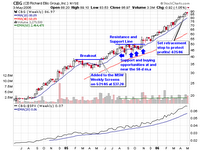So where does system development start?
Investors will be prepared to trade in situations when the odds are in their favor by properly understanding position sizing techniques and calculated system expectancies. A system that has been tested will have an approximate expectancy that will tell the trader how much will be gained or lost during each trade over a period of time. Using this knowledge, the investor will determine how much risk to undertake by calculating a position sizing algorithm which tells you how much to place on a specific trade. The word ‘algorithm’ sounds scary but I have developed very simple position sizing and expectancy spreadsheets that can be found through the links below. They can be downloaded, studied and tweaked without any advanced spreadsheet or mathematical experience.
Most traders look for three major factors when developing a system:
- How much to trade on each position
- The right odds or positive expectancy
- Number of trades or how much opportunity the system presents
How do we Calculate Position Size?
We can determine how much to place on each trade by assuming a $100,000 account with 1% risk on each position. Using a basic trading approach, I will place my stops approximately 8% below the ideal entry area or pivot point. Please use more advanced methods for locating the ideal stop rather than a general 8% (I am doing this for example purposes only). Look for the ideal risk-to-reward setup based on recent support and resistance levels and set your stop and potential target accordingly.
$100,000 Account
1% Risk = $1,000
8% Stop Loss
Position Size will be $12,500
We calculate the position size by dividing the 1% risk by the 8% stop loss or $1000 / 8% = $12,500.
If the stock we are watching has an ideal entry of $50, we now know that we can buy 250 shares or $12,500 worth of stock. Our stop loss is $46 or 8% of $50 and our maximum loss is $1,000 of the original $100,000 portfolio.
What exactly is expectancy?
Expectancy tells you what you can expect to make (win or lose) for every dollar risked. Casinos make money because the expectancy of every one of their games is in their favor. Play long enough and you are expected to lose and they are expected to win because the “odds” are in their favor. Most games at a casino are completed in a short period of time so they can increase their odds of winning.






Connect with Me